“Let me tell the story, I can tell it all
About the mountain boy who ran illegal alcohol
His daddy made the whiskey, son, he drove the load
When his engine roared, they called the highway Thunder Road.
Sometimes into Asheville, sometimes Memphis town
The revenoors chased him but they couldn’t run him down
Each time they thought they had him, his engine would explode
He’d go by like they were standin’ still on that Thunder Road…”
— “The Ballad of Thunder Road,” words & music by Robert Mitchum, Don Ray & Jack Marshall
This month marks the 58th anniversary of the release of the cult classic Thunder Road, much of which was shot in and around Asheville. Despite its humble origins as a low-budget B flick, the film has endured over the years, especially among a certain segment of movie fans. In addition, it has earned a special place in the hearts of car and racing enthusiasts the world over.
Thunder Road is a story about mountain moonshine runners (“The definitive moonshine picture” – Leonard Maltin), big-city mobsters, fast cars and the Treasury agents (“revenoors”) who chase them, along with a girl or two tossed in for good measure Its story line would later be exploited ad nauseam in other films, but was still fresh in 1958. The movie has always held a special attraction for men, many of whom have fond memories of either seeing it at their local theater or watching it with their dad or granddad at home. A strong antiauthoritarian streak runs through it, another reason for its appeal to young males.
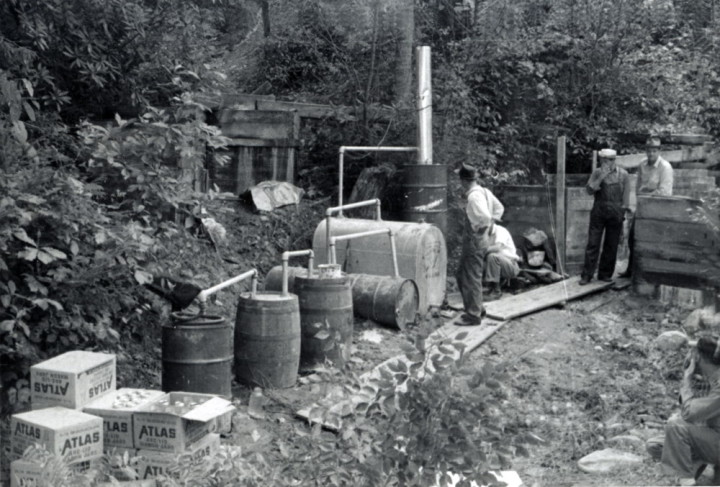
Among other notable achievements, Thunder Road is the movie that launched the muscle-car era in America, according to classic car expert Pete Dunton.
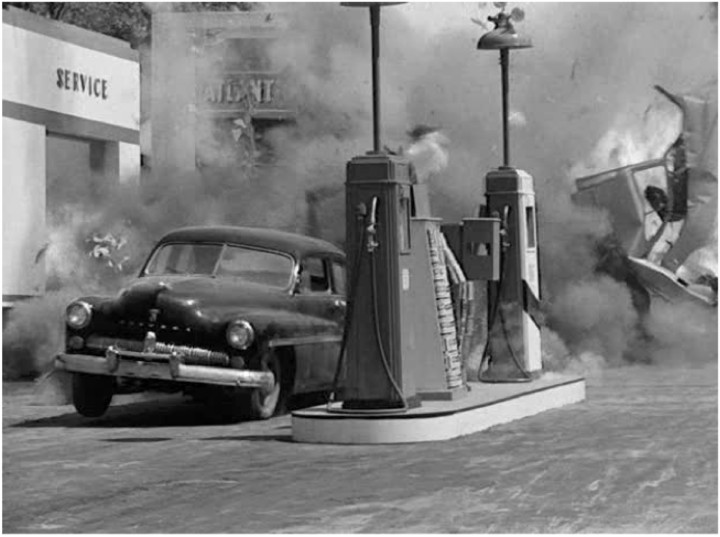
“After Thunder Road, things would never be the same again (in the car world),” according to Dunton. Embedding it even more deeply in the popular culture was Bruce Springsteen’s 1970s rock anthem “Thunder Road,” the title of which he took from the movie poster. Other incarnations of the name have included amusement park rides, horse racing events, songs, mobile comics, rock bands, board games and even an alcohol distillery, just to name a few.
And if all that weren’t enough, a 1975 spinoff, a movie called Moonrunners (featuring Robert Mitchum’s son Jim) served as the inspiration for the wildly popular 1980s TV show “The Dukes of Hazzard.” All in all, not a bad legacy for a little movie made in a few short weeks on a shoestring.
Robert Mitchum, known for being something of a maverick himself, had wanted to do the film for a long time. Having previously spent time in the South (he had family in South Carolina), he nursed an admiration for the independent, rebellious spirit of the region, especially the mountain culture of Western North Carolina and east Tennessee. If that part of the country had an “attitude problem,” it was one that Mitchum liked and attempted in some ways to emulate in his own life. From the start, Thunder Road was his baby. In fact, it was he who largely pulled the finances together for the project, while also serving as the film’s producer and co-writer. He even composed some of the music and lyrics and, it was rumored, directed several scenes himself. Making it a family affair, he cast his oldest son, Jim, in the part of his kid brother Robin (a role, according to Jim Mitchum, originally slated for Elvis Presley). All in all, this was one project where the sleepy-eyed actor, famous for his “I don’t give a damn” attitude both on and off the screen, was all in.
The movie was released in May 1958 with little fanfare or advance publicity, and received almost no attention from the critics. It seemed destined to die a quick death, buried and forgotten along with a thousand other films of similar low pedigree. Except it didn’t.
Instead, it stuck around, seldom receiving top billing at first-run movie houses, but frequently appearing as the second or third feature on a twin or triple bill, usually at an outdoor venue. In fact, it was probably the drive-ins, once so popular, that both saved the movie and eventually turned it into a cult classic. The movie remained especially popular in small towns throughout the South and Southeast, where the so-called “car culture” first took firm root in the 1950s and 1960s, not to mention the cradle of NASCAR.
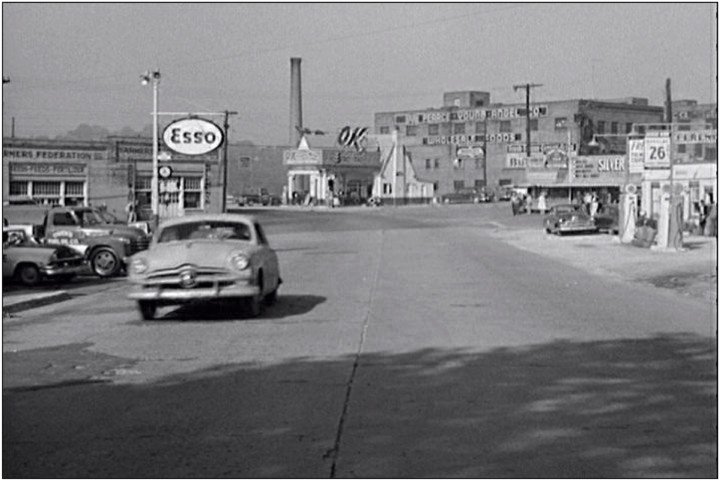
At the heart of the story is the Mitchum character Lucas (Luke) Doolin, a tough, resourceful veteran of the Korean War, who, now that he has returned home, is resolved to carry on with the family business of making and “runnin’ moon” through the mountains. He becomes even more determined in his role as a “whiskey man” when challenged by government agents intent on squelching the illicit trade, along with syndicate thugs out of Memphis looking to horn in on the business.
“The movie respects the traditions of the Scots-Irish, who have a long tradition of moonshining and fierce independence,” says Michael Gouge, a lecturer of mass communication at UNC Asheville. “It also shows the encroachment of the modern world into the traditional family-based clan systems. The cars in the movie illustrate the postwar rise of hot rod culture. Skilled veterans home from war often sought out fast cars and motorcycles to capture some of the thrills they became accustomed to during the war.”
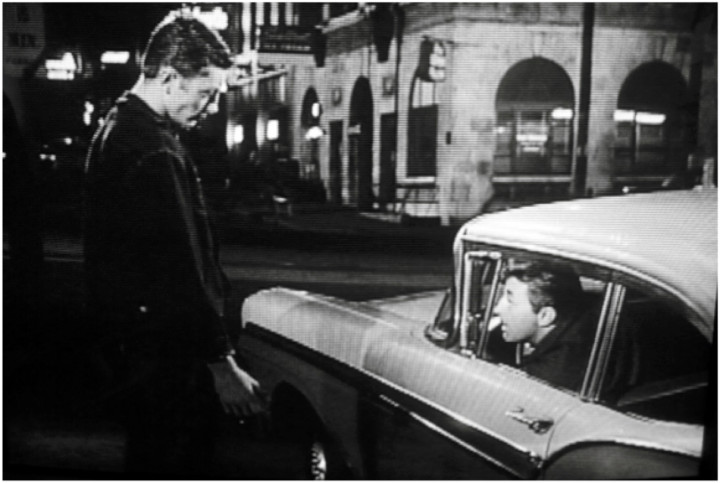
looking up Market Street.
Photo courtesy of Park Circus
Like the movie cowboy hero of old, the Luke Doolin character lives by an inner ethic, one based on a “don’t tread on me” principle of personal freedom and self-reliance. And while, like those older Western heroes, Luke is a peace-loving, neighborly man with a long fuse, he will only be pushed so far before pushing back. Once riled, watch out, you might just get your hat smashed (watch the movie to learn about that.) Above all, he insists on being his own man and living strictly by his own rules (“I don’t fix; I don’t buddy up with one living soul,” he tells his brother). These were qualities Mitchum himself admired in mountain folk, romanticized as perhaps they were. His character would in turn embody them in the film, right to the bitter end.
As it turned out, audiences loved it. “They [Hollywood] didn’t really understand the movie,” Jim Mitchum has said. “They didn’t have a clue who the audience was for the movie. Yet it has never been out of release in 50 years [plus]. It’s shown somewhere all the time.”

Local Memories
Fifty-eight years later, many people around Asheville still vividly recall the making of Thunder Road. Here’s a sampling:
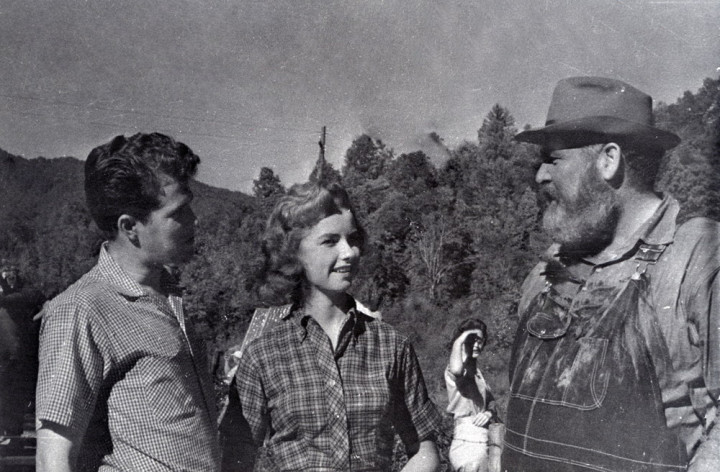
“My father, Charles Elledge, was an educator and served as the principal of Marion High School in the 1950s. He also had a passion for acting and over the years appeared in various films and TV productions. He played one of the moonshiners in Thunder Road. It was a small part, but one he enjoyed. My dad had a big, imposing bearing, but [was] very congenial. He liked playing characters like this — he played Preacher Sims for years in “Horn in the West” in Boone — and he knew how to portray them with authenticity. He and Robert Mitchum became friends during the production.”
— Cherie Elledge-Grapes, Dallas, N.C.
“I remember the producers coming to buy some of their cars from my dad and uncle. I also remember both my dad and uncle having to go to Sandy Bottoms to teach them how to spin the cars out without running them in the river. A federal agent came to our house a few times looking for moonshine, as my family were moonshine runners after World War II.”
— Bill Parris, Asheville
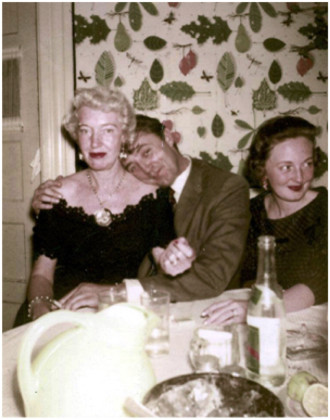
“Perhaps the most exciting event ever to take place at the Sky Club was when Robert Mitchum came to town to star in Thunder Road. The whole town was star-struck, and one scene in the movie was shot in the restaurant. A couple of my friends took the entire week off from work just to be extras in the nightclub scene. Mitchum cut a wide swath [in Asheville]. He and his wife stayed at the Battery Park Hotel, and it was widely rumored that his mistress was staying down the street at the Vanderbilt. Mitchum spent most evenings at the Sky Club, though, drinking, dining and dancing with the ladies who absolutely threw themselves at this tall, handsome movie star. I witnessed more than one violent confrontation precipitated by a husband’s or boyfriend’s jealous rage, but Mitchum was big enough to take care of himself — and, after all, all he was doing was dancing.
— Jerry Sternberg
“I was probably 12 or 13 when the movie was made in Asheville. I remember that some local folks got some bit parts, like the well-known WWNC radio announcer Farmer Russ (Offhaus). I also remember a fellow Boy Scout I met at summer camp who was wearing a neckerchief slide carved from a piece of scrap balsa wood that he said was from some of the debris of a wreck scene in the movie where the car crashed through some rail posts. His dad had some connection with the location shot, I think. A classmate of my older brother at Owen High crashed his ’52 Ford trying to duplicate that 180-degree spin in the scene at the bridge.”
— Steve Norwood, Asheville
“I was an 18–year-old high schooler who ran into Robert Mitchum one night. As teenagers, we ended many of our nights at the Hot Shot Café in Biltmore Village for a late-night grilled cheese sandwich, Coke and a good bull session. All of a sudden, the doors opened wide and in walked Robert Mitchum and his posse. We were all stunned. They said nothing but strolled to a large table. They were a rough-looking crowd and probably had a bit too much to drink. We continued to stare, not saying anything.”
— Stan Cocke, Asheville
“I was present when the sports car club had an autocross event at McCormick Field and Robert Mitchum’s son drove the ’50 Ford being used in the movie through the gate in right field and around the track, causing them to halt the event. The announcer made a very sarcastic remark, and Robert Mitchum left.”
— Jerry King, Asheville
“My uncle was Howard Penland, who was raised north of Weaverville on Ox Creek Road. His wife, Clara, told me years ago that that there was a time when the folks who lived on Ox Creek Road and Reems Creek Road were concerned that there might be an illegal moonshine operation near the Beech community. The reason was that they would occasionally see a hot rod car headed toward Weaverville at a very fast rate of speed. They were relieved when they later learned a movie called Thunder Road was being filmed in the area.”
— Danny Starnes, Black Mountain
“My great-uncle Joe Gouge was a moonshiner out of Mitchell County. Our family surname is used in the movie with the character Stacey Gouge, but the actor mispronounces it. Our name isn’t spoken like it’s spelled, but rhymes with Baton Rouge.”
— Michael Gouge, Asheville
“NASCAR pioneers Fireball Roberts and Banjo Matthews of Asheville and all the guys that were there to build the cars were on the set. There were also a lot of active moonshiners around all the time.”
— Jim Mitchum
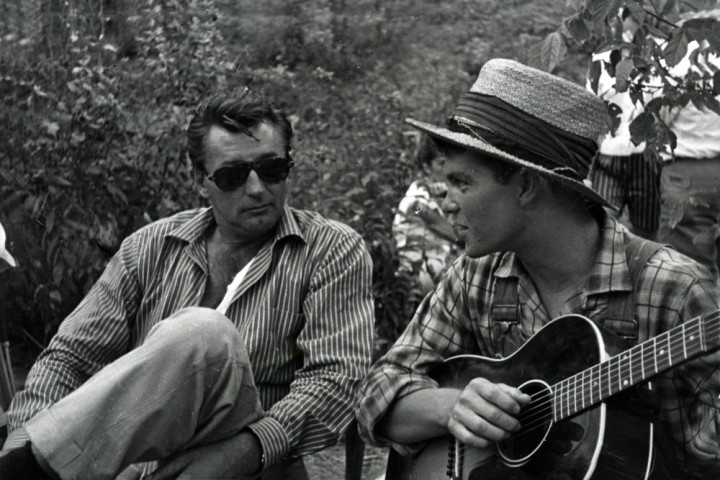
Musician Randy Sparks recorded the “Thunder Road” theme song for the movie soundtrack when he was 25 years old and just out of the Navy. He would go on to found the popular 1960s folk-pop group The New Christy Minstrels. Sparks recently shared his memories of the making of the film:
Robert Mitchum saw me on “The Bob Crosby Show” on TV, in uniform, and told his agent, ‘That’s the guy I want to play my kid brother in Thunder Road. I learned many years later that he had probably pulled strings with the secretary of the Navy to get me an early release, and I went from Washington, D.C., to Asheville on my first day as a civilian. I had also been contracted to write and sing songs for the movie, and I had my lead sheets in hand upon arrival. But at the Battery Park Hotel, headquarters of Mitchum’s film company on location, I was told by Bob himself that my assignment had been significantly altered. His 16-year-old son, Jim, had lobbied him to play the acting role, and in the time between when I was contracted and my arrival on location, the title song had already been crafted by veteran songwriter Don Ray, with Mitchum’s collaboration, but I would still be the one to sing it. Bob politely refused to listen to my song titled ‘Thunder Road,’ but he wanted to hear ‘Whippoorwill’ (the alternative title), and he allowed that they might make use of it in a scene later in the film (Keely Smith sings it at the close of the film). I was disappointed, of course, and I had a right to be angry, but maintained a positive attitude. I was, after all, a nobody with zero movie credits, an outsider fully unprepared to combat nepotism, hardly a bona fide actor, so if anything, I probably felt somewhat relieved.
The social ambiance with the cast and crew in the lobby of the Battery Park reminded me of a meat market, and this was terribly disappointing. I had for 18 months in uniform refused to stoop to the level of the traditional image of sailors on liberty in a seaport, and I now felt like walking away. I spied a pretty girl about my age standing in one corner of the sprawling room and looking very much out of place, so I walked over to her and said, “You don’t look pleased to be here.” “I think I’m in the wrong place for the wrong reason,” she replied. “Bob just told me that I would be having a private dinner with him in his room, so that we could go over the script together, and I’m not that kind of girl.” “How would you like to have dinner with me?” I asked. “That’s the best offer I’ve had all day,” she said, and I led the way to the hotel’s dining room. Mitchum shortly came along, overtly expressing his dismay, and I thereafter faithfully served as her chaperone. I can assure you that she was untarnished by the evils of Hollywood in the coming weeks, but I had instantly forfeited my billing in the picture. Of course, I didn’t learn this sad fact until much later, and I’m still somewhat amazed that they left in place my vocal performance over the credits, which, by the way, wasn’t necessarily a boon to my musical career. Jack Marshall, the orchestrator, had written the instrumental track two or three keys too high for my voice, and I sound like a castrate. I begged for a change of key, but he refused. ‘We’re already over budget,’ he grumbled.
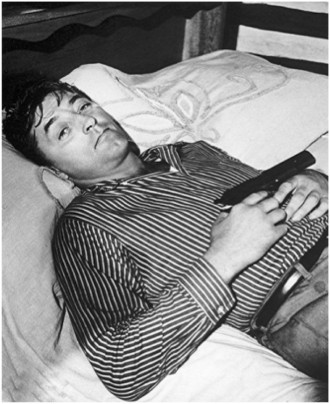
Chris Mitchum Remembers
Chris Mitchum was just 13 when he first visited Asheville in the 1950s. He was playing the proverbial kid-brother role at the time, tagging along, as it were, with his father, actor Robert Mitchum, and his big brother, James. I recently asked Chris Mitchum what he remembered most about the making of the movie. He told me that one thing he recalled was the technical people who worked on it. “The advisers were interesting,” he said. “There was a Col. Tom Bailey, I think it was, from the federal Bureau of Alcohol, Tobacco and Firearms. I remember him saying that, at the time, the manufacture of illegal alcohol was one of the top 10 businesses in the United States. Bigger than the Chrysler Corp. Two out of every three bottles sold in the U.S. were counterfeit. There was a 500-gallon working still on the set run by real moonshiners. They and the colonel all knew each other. The colonel said that the moonshiners were very honorable people. They would do just about anything to not get caught, but, once caught and told when to be in court, they showed up.”
Chris Mitchum said that when the film was over, his father asked if he could have the still, and Bailey said yes. However, it never arrived. “I suspect Col. Bailey may have given it to one of the moonshiners,” he said. “The car stunts in the movie were all driving maneuvers that the runners used to escape,” Mitchum told me.
“There was the instance when legendary Hollywood stunt driver Carey Loftin drove into two cars facing each other to block the road,” Chris Mitchum recounted. “He hit them at 80 miles per hour, and the damage to his car was much worse than expected. When his car came to a stop, everyone ran to it to see how badly he was hurt. When we got there, he rolled down his window, a cigarette in his mouth, and said, ‘Anyone got a light?’ It’s been said that Thunder Road is the film that started serious car stunts in movies.” Loftin went on to work on The French Connection, Grand Prix, Bullitt, Vanishing Point, Duel, and Days of Thunder.
One of the most vivid memories the then-adolescent Mitchum recalls is the evening he and his father went to dinner with Keely Smith. Smith, who played Robert Mitchum’s love interest in the movie, was a Grammy Award-winning jazz and pop singer in the ’50s. She sang “Whippoorwill” on the Thunder Road soundtrack. “My father said he was going into the bedroom to get ready. ‘If Keely arrives, offer her a drink,’ he told me. About 10 minutes later, there was a knock on the door, and it was Keely. I offered her a drink and she said, ‘What’s there?’ My dad kept a fairly complete bar. There was even moonshine from the working still. Keely opted for that. I put some ice in the hotel glass and poured a little shine. ‘Fill it up,’ she told me, so, OK, I did. The shine was incredibly smooth, and by the time my father walked out of his room, she had already finished it. ‘Ready?’ he asked her. ‘Ready,” she said. She stood up, and then fell over. She was out cold. My dad was horrified when I told him what she had drunk. He picked her up, put her on the couch, and he and I went to dinner.”
Postscript: If you see the movie, watch for the scene where some country boys are playing music outside a general store. The kid in the back playing the washboard is Chris Mitchum. “It was my first acting role,” he said. “It paid $10.”
Joe Elliott is a writer and educator living in Asheville. He wishes to thank to everyone who contributed to this article, and offer a special thanks to Michael Gouge at UNC Asheville for helping identify location shootings from the film.
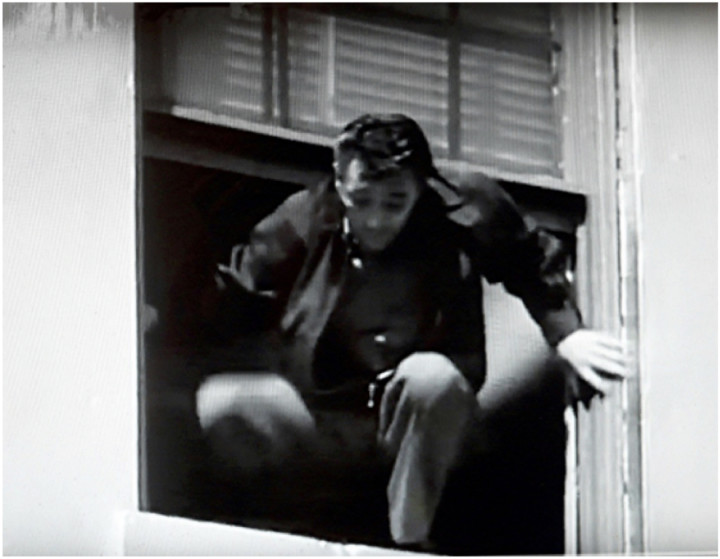


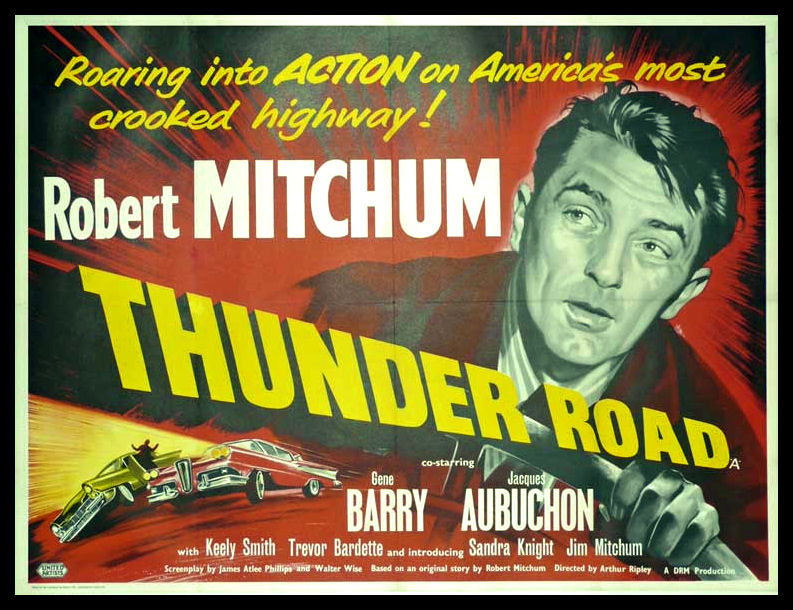
I didn’t realize this was filmed in Asheville.
The scene where he was arrested was filmed where FLS Energy is. In fact the road is partially still there but fenced off and used as a storage area. Also the old Playworld building on Merrimon is in it and was a grocery store.
the street where he got arrested was e. haywood rd under the park rd bridge.
Your article says the tickets are $5. The link to order online lists tickets as $8. Where can I buy my tickets for the lower price? Thanks.
Melanie: The tickets are actually $8, not $5. Sorry for the erroneous information.
Used by permission of the author —
I’ve been a fan of the movie since the first time I saw it at the Prairie Lake Drive- In in Orlando Fla in 1958 or 59. Have probably watched it 25-30 times and have a copy that I pull out every few years.1- I met with Red Hoyle, owner of Hoyle’s Office Supply, years ago to discuss his participation in the movie as owner of the location where the bad guys operated. “That’s right cousin, we got mills that will blow that heap of yours right off the road”. Red negotiated directly with Robert Mitchum (producer?) for use of his facility. Red said he was a great guy and real easy to deal with. For the movie, Mitchum built a shed in the alley behind Hoyle’s to store movie equipment and as payment for use of the facility, Red accepted the shed as full payment. That shed may still be there, I was when I talked to Red.
A friend of mine, Doug Stafford told me his dad (later owner of Stafford Fender Motors in Black Mountain) was a body man at Matthews Ford and supervised the repair work on the Fords used in the movie. As the movie was mostly shot during the day (and tinted to look like night?) the repair work was done at night. Mr Stafford worked all day on Matthews business and all night on the movie cars.
Bill Berdahl
Bill,
I don’t know how I stumbled onto this website. How have you been? Still living in Asheville? I’m in Wilmington.
Actor Jim mitchum bought the 51 ford movie car and brought it back to california to go to high school in. thanx
Used by permission of author —
My Daddy’s company, Merchant Construction Company built all the local sets for the movie. As I remember it, there were some scenes done on Market Street. The garage scenes were done at my Uncle Bob Wilson’s Garage in Weaverville. The still was built up Reems Creek. I think the graveyard was up there, too. The motel scene may have been filmed on the road out to Weaverville, too.
The last scene was filmed on old Hall Street. This street ran from River Road up to Patton Avenue in the general area of where the big intersection is just to the east of the Bowen Bridge over the river. I don’t know if they used an abandoned filling station or if they built one from scratch. Daddy used to tell stories about how they had to make rain when required and how they did the scene where the star rammed his car through a road block.
My sister has a lighter that Robert Mtichum gave him. It has the star’s name engraved on it. My, such memories! I was around 7 at the time and will be 66 this coming December so it is a REALLY long time ago. Ha! I wish I could show up to see the film. I have it on a VHS tape.
Gary Ray
The gas stn was a fake mockup on a dirt lot down by the river. A chain from a tow truck was used to pull the mercury over at the station.
Used by permission of the author —
My cousin on my mom’s side, Linda Bender, maiden name Linda Lee Hyer, and I were extras in “Thunder Road.”
Our roles were as teenagers walking home from school. I still remember the dark purple skirt I was wearing. What I remember most is that my mom, Willa Cole, was working at the Battery Park Hotel as a room clerk. Consequently, she met Robert Mtichum and the cast and crew when they checked in to the Battery Park. She was divorced from my father and was a very outgoing and beautiful blonde.
Well, I remember she told me she was going out to dinner with some people. I think it was a school night. Anyway, I was sound asleep and she came into my room and woke me up, saying, “Wake up, wake up! Robert Mitchum is in the living room!” So I sleepily walked into the living room and met the good-looking but droopy-eyed Robert Mitchum!
I met several other members of the cast and/or crew but remember nothing about them. He was very nice to me. He even said, “You sure are a pretty little thing. If you were a little older, I’d put you in my movie!” My mom, who had always wanted one of us to be a movie star, jumped at this, stating, “She has an older sister! She’s away at college.” Long story short, she was flown home from college to try out for the part but ended up not doing the film, but going back to school.
Sharon Rich
Used by permission of the author —
Thunder Road is one of those movie that if you see at a certain time in your life, you never ever forget it.
I never could decide if the Robert Mtichum character was wise or foolish, you know. He definitely lived by his own rules, but when offered a chance to escape prison (and death) and do it in an honorable way, he turned it aside. Maybe it was because he didn’t want to rat on his friends, but that’s not what the fed agent was asking, at least not as far I could tell. He was just looking for a little cooperation in busting the real bad guys, the mobsters. The Mtichum character was like, “nope, I’ll go my own way, right down to the end.” Maybe that’s admirable, maybe it isn’t. I don’t know.
The night scene on the street (shot in downtown Asheville) is my favorite. It’s a moment when these two actors, father/son in real life, seem like they really are part of the same blood, family. Robert Mtichum was never cooler than in that scene, in my opinion.
Chad W.
The night scene was my favorite too. It was on the corner of market and walnut st across from the asheville medical bldg.
Yes, the Fed wasn’t after Luke. But he understood he and the locals would be next to fall. For whatever reason, he wasn’t afraid of the Feds. They had come and gone before? But the mobsters were a deadly bunch, and had to be dealt with, as necessary.
Used by permission of the author —
Joe, I enjoyed your article about the filming of “Thunder Road.” I was 15 at the time and a member of the Canton YMCA Clogging Team. We frequently danced for conferences at the hotels in Asheville and happened to be performing at the Battery Park Hotel when he was staying there. All 16 of us were invited up to his room where we found him in a navy bathrobe and Keely Smith in a white bathrobe. She disappeared but he talked with us and wrote comments and autographs for every one of us.
Linda Smathers
Asheville
Used by permission of the author —
Portions of “Thunder Road” were filmed in the Reems area (Mundy Cove, Reems Creek Presbyterian Church, and Beech Community. One group scene was filmed at Beech School which is near my home. Some of my friends stayed out of school hoping to be filmed in a group shot. I planned to “miss” the school bus on the day of the filming but my mother went out and had the bus driver wait for me. I missed my chance to be in the movies.
Frances Ballard Koon, whose family was from the Ox Creek area, played the part of the mother in the early scenes. Frances was my mother’s cousin and although she was active in local theatre, she had no other acting experience. I don’t know if this should be mentioned, but there were folks in our community who thought it was wrong to go to the movies, but made an exception and went to see “Thunder Road”
The bootlegging Penland family from the mountains caused some teasing for my husband’s uncle when the movie came out. He was working out west and his co-workers kidded him about being a bootlegging Penland from the Appalachian Mountains.
Wilma
Used by permission of the author —
Out on the lost highway
Riding shotgun through the night
Have to make to Memphis
Got to lay my burden down
Thunder Road, Thunder Road!
These lonely mountain roads
Haunted by the shadows of the men
Who crossed them long ago
Bringing with them nothing but their dreams
Thunder Road, Thunder Road!
Got just one more run to make tonight,
Just one more load to deliver
Then I’m goin to let it all go,
Goin back to the girl I love
Yeah, goin back to the girl I love
Thunder Road, Thunder Road
Oh don’t you do me wrong
Got to make it back home by morning
Back to the arms of the girl I love
James aka “Big Daddy D”
My Uncle Bill Banner worked as a TV cameraman for WLOS and covered the shooting of this movie. One day Uncle Bill invited Robert Mitchum to his home for Sunday dinner by saying “you must be tired of hotel food by now”. Mitchum accepted, came, and stayed for 3-4 hours. My uncle said he was very nice, a regular person, did not act like a “star”.
In the opening of the film the 50 ford flips over. The stuntman was going to spin the car around but hit an obstacle under the dirt at the side of the road and flipped instead of spinning the car around.
The most iconic scene in the film is when there is a car chase between Luke and a cop. As the cop pulled up even with Luke’s car in an attempt to run him off the road, Luke flicks a lit cigarette through drivers side window into the facr of the Cop.
This was filmed at Toxaway Falls near Brevard,NC. The Cop crashes through a guard rail nag tumbles down the falls.They used a real car and pushed it over the falls.
The guy was not a COP. He worked for Carl Cogan. Cogan called him “Blackie”. Cogan told Blackie to Take Doolin out. Blackie replied My pleasure. I like handling these bust out characters.
That scene shows Blackie’s black 1957 Ford crashing off the road and rolling over and over down the wooded slope.
The scene where the car goes off the road and crashing down the waterfall was an earlier chase scene. If you look close it was a cheaper 57 Ford with the engine and transmission removed. The car before it “went” down the falls was a new 1957 Ford Fairlane. Look close at the scene and you can see the switch.
I seen that very sameclip used on Perry Mason just 2 nights ago.
The character’s name is Lucky.
I’ve watched the movie for an untold number of times. To make sure I watched it again.
Of note, the scene at the night club when Lucky gives the “Speed Shop” business card to Dooling, it has Memphis as part of the address.
The scene where Doolin goes to the “Speed Shop” was in Asheville.
Every time I watch the movie I hope Doolin survives the crash at the end.
No, he flicked his cigarette at the heavy working for the bad guys. His real name was Pete Hornsby from Columbia, SC. Pete died about 1998 in Columbia.
I have seen this Greatest Car Movie so many times I have it and the dialogue memorized.
Jim mitchum took the 51 ford from the movie back with him to california.
It was a 1950 Ford. Not a 1951.
THe car was a 1951 FORD Coupe, with a 1950 front fenders & a 1949 hood with the letters removed I have several picktures of the car, But after the car was taken back to Jims house they put a 50 FORD crest on the hood where the letters should be & repainted it black
THe car was a 1951 FORD Delux Coupe you can tell by the dash, with 1950 front fenders you can tell by the single bullet in the grill & a 1949 hood with the letters removed, I have several picktures of the car, But after the car was taken back to Jims house they put a 50 FORD crest on the hood where the letters should be & repainted it black however it still has the 1949 hood ornament
Dan, so Jim had the ’51 painted black after it was shipped to California? I’ve been in contact with the gentleman who owned the car from late 1959 to 1962 and learned about the many changes he done to it. We are interested in more history on the car and if it is still out there today. I would very much like to see the photos you have if possible.
Thunder Road is by far the most exciting movie I have ever seen in my lifetime. I was nine years old in 1958. I first watched “Thunder Road” when it was first shown on TV. My sister and I looked every Sunday in the TV Times booklet hoping to see it again. I especially remember watching “Thunder Road” on Sunday June 5, 1966 right before I went to my high school graduation ceremony. In later years I recorded it on my VCR and then bought the Professional Made VHS copies just to get the pictures on the cover. And later the DVD’s. I have always loved Fords, especially the 1957. To me, the ’57 Fairlane 500 is the most beautiful automobile ever made. Sadly I have never owned one. Hopefully someday. Does anybody know what colors the 1957 Fords were in “Thunder Road” ? I watch “Thunder Road” every year on April 1st and other times during the year as well. Thank You All for the great stories.
In 1959 my father and I were at one of the junk yards on the French Broad River close to where Southern States business is. There were two 1957 Ford Fairlanes with no mechanicals but identical except for the color. Medium green with light green and medium blue with light blue. They were rolled and looked like twins except for colors. They were back up to the river. I can only guess that were used in the movie. On black and white format, the color schemes may show up similar to the movie goers.
I was 11 when it was filmed and remember the ads in the paper for hot rod cars to use in the film. It did have some inconsistencies but I loved it when it opened and even more now.
Charles C
Did the early coupe hav ea cat or olds motor or does anyone know? Please let me know if you respond at rhall@damson.com. Thanks Rick Hall
The 1951 FORD had a 57 T bird motor with 312 & 3 duces 5 2 barrel carbs, Can Anyone tell me where the House where the wooden garage was where Robin would work on Lukes Fords ? What road was the Doolin house located on ?
The house is on Mundy Cove Road in Weaverville.
Wasn’t some of the Highway scenes filmed on US 441, below Norris Dam along the Clinch River in Tennessee?
The entire movie was filmed in North Carolina. Asheville, Weaverville and Brevard.
The only movie I have ever seen more than twice and I’ve lost count of the actual number. Always watched it at a drive in. It came out my junior year in high school and captured our following. Probably saw it half a dozen times the first month.
I’m from Bristol TN and when I was a kid my uncle used to tell how him and a couple of his buddies rode over to Ashville to see them film some of the movie back then.
When a movie is made where you live it holds a special place in your heart. I remember when Barbara Streisand and Ryan ONeal did “What’s Up Doc” in San Francisco, blocks away from where I lived, it was a moment. It kind of represents you in a weird way; I get it. It’s like a stroll down memory way whenever you see the movie!